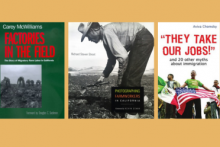
Library graduate student researcher Carlo Acevedo created a reading list for audiences interested in learning about the history of the labor movement.
Acevedo worked on the project over the summer under the supervision of librarian Elizabeth McMunn-Tetangco, in collaboration with the UC Merced Community and Labor Center (CLC).
“I compiled texts on the multilayered and rich history of the labor movement and working class, mainly focused on this equally contradictory and beautiful geography that is the Central Valley,” says Acevedo.
His annotated bibliography recommends resources for a proposed public reading room at the CLC and covers the philosophies and theories that have guided the labor movement, its history, documentation, as well as the role of the arts.
“It was inspiring to notice how the struggles and hopes of the people have been expressed through so many languages and registers: historical texts, essays, poetry, fiction, non-fiction, and visual arts.”
Acevedo is a Colombian graduate student in the Interdisciplinary Humanities program who studies Latin American contemporary poetry. He is a writer and an organizer in his statewide union. He shared his impressions from his work this summer:
“One of the most astonishing discoveries was a lineage of photographers who committed to capturing, through photo documentaries, the beauty, the glory, the harshness, and the tragedy of the conditions experienced by the farm workers who have labored on this land.
The working class has found inspiring and creative forms of organizing. Of course, labor unions and political parties are and have been fundamental to pursuing the worker’s interests, but the people, on different occasions, realized that more passionate and relatable expressions of collective action and community building were also crucial to building more broadly their interests and wellbeing.
Education, religion and spirituality, and arts have been some of the disciplines, beliefs, and practices that have permitted workers in the United States (and abroad) to improve their living conditions and fight for their causes.”
The online research guide serves as an overview, including “Labor Movement for Starters.” Acevedo has compiled more extensive bibliographies, available in Zotero, on the History of the Labor Movement and the Labor Movement in the Central Valley.


